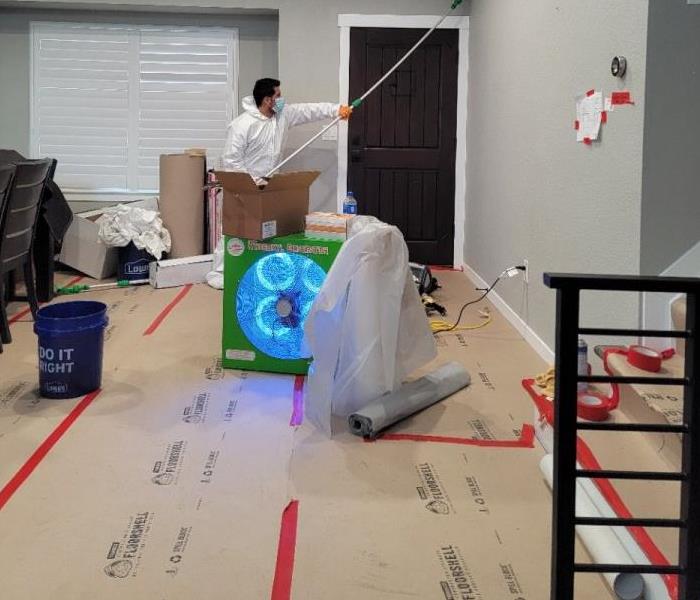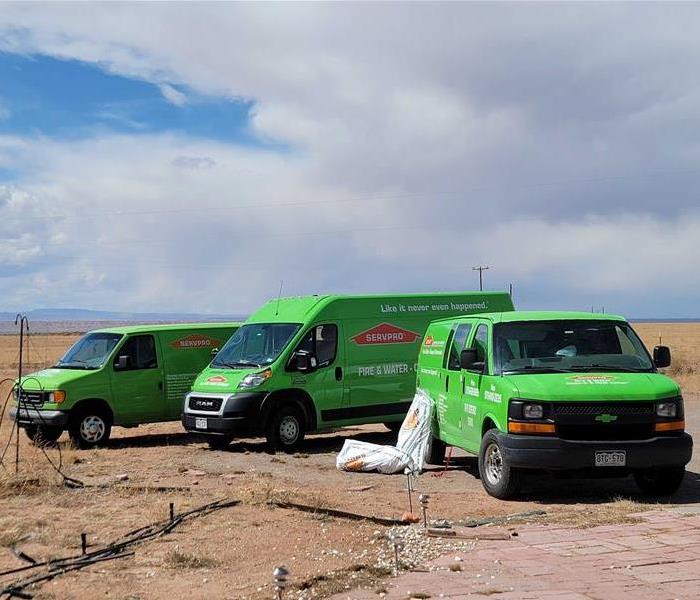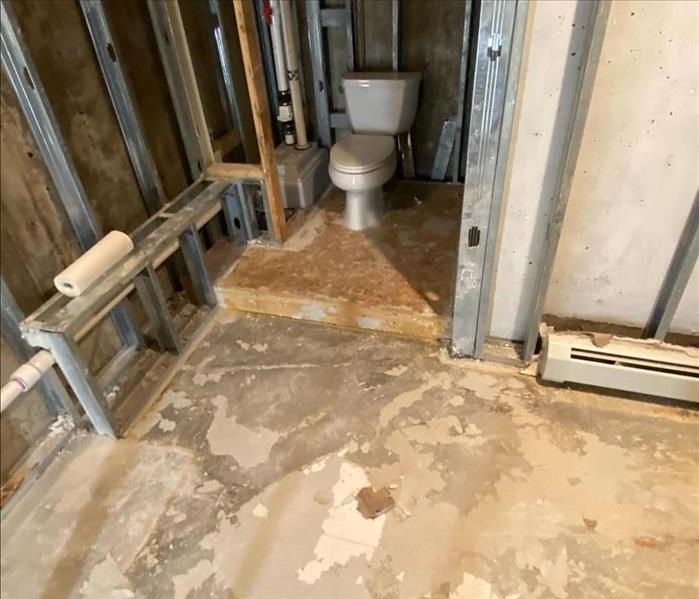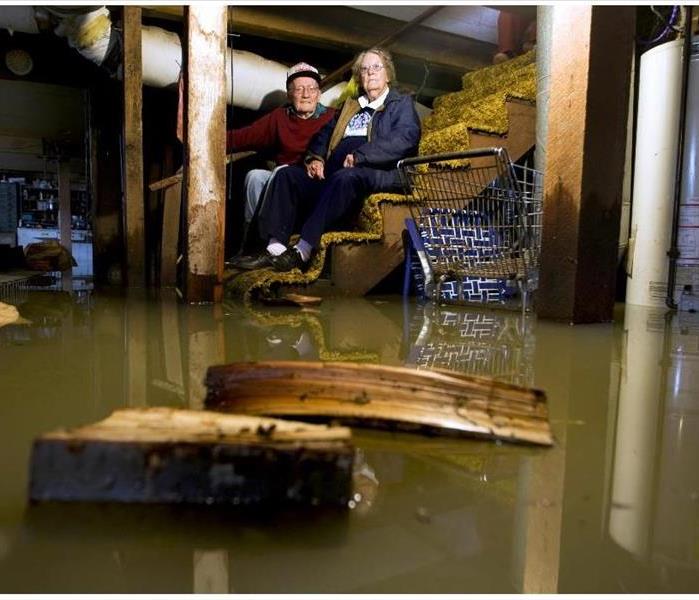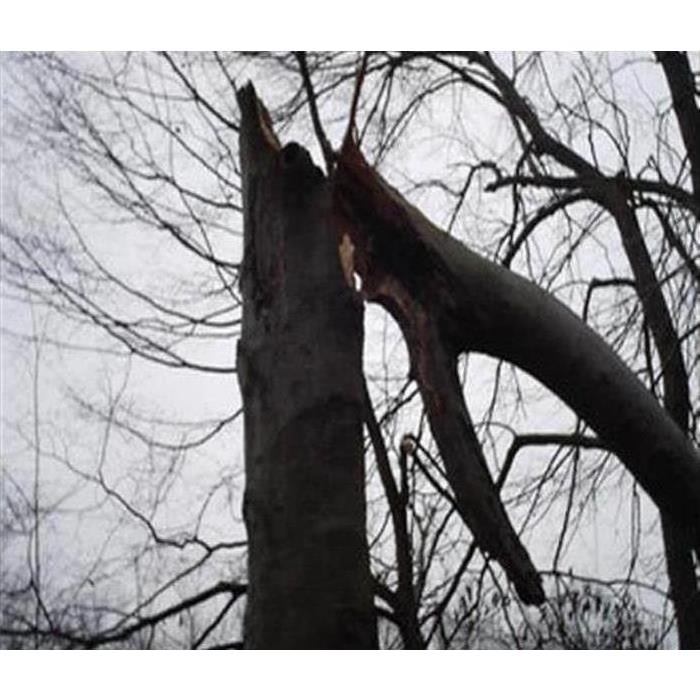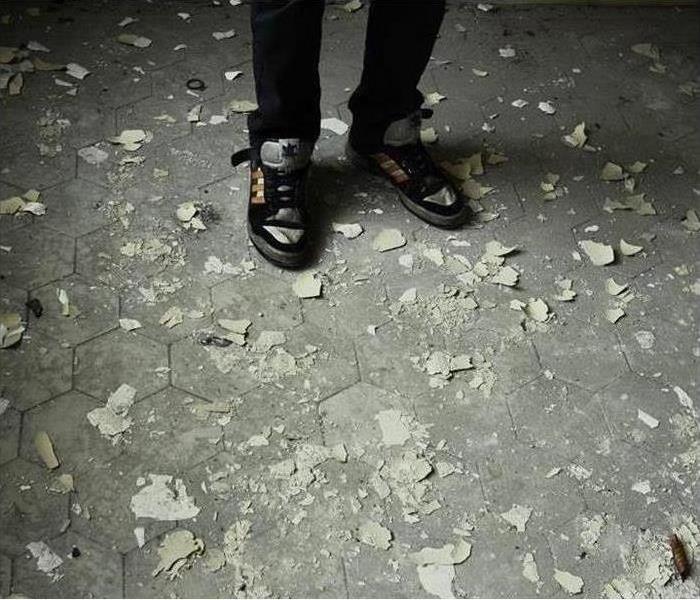Archived Storm Damage Blog Posts
How to be prepared for the windiest months in New Mexico?
5/23/2022 (Permalink)
Everybody familiar with New Mexico's weather knows that the windiest months of the year are April and May, with March and June frequently following closely behind. The highest wind events are most common in the Spring.
It is critical to be aware of the risks that come with them. The National Oceanic and Atmospheric Administration provide wind warnings, watches, and advisories:
High Wind Warning: Take Action! There are sustained high winds with significantly stronger gusts. Seek refuge. Keep both hands on the steering wheel if you're driving.
High Wind Watch: Be Prepared! It's possible to have sustained, strong winds. To avoid being trapped outside, secure unsecured objects and change plans as needed.
Wind Advisory: Take Action! Severe winds are present but not strong enough to warrant a High Wind Warning. Outdoor objects should be secured, and driving should be done with prudence.
Severe Thunderstorm Warning: Take Action! A thunderstorm is happening or is imminent in the warning area. Severe thunderstorms have 58 miles per hour wind gusts and hail one inch larger. Seek shelter inside a sturdy building.
Be prepared for High Winds.
- Remove any dead trees or branches that are overhanging structures.
- Remove loose things that could blow away from patios, roofs, or balconies.
- Securely close windows and reinforce exterior doors.
- Bring in any unsecured items from outside and secure anything that could blow away and cause injury or damage.
If your home or commercial business needs storm damage restoration services, SERVPRO of NE Albuquerque has a team of highly trained storm damage specialists available 24/7 to help you get back to normal. Call us today at 505-828-3567
Staying safe in after a flood in New Mexico
5/23/2022 (Permalink)
Flooding occurs when water overflows from a few inches deep to completely engulfing entire buildings. Flooding can happen when rivers and lakes can't handle too much rain or snowmelt or when rain can't be absorbed completely.
It's critical to know the difference between watching and a warning to know what to do to stay safe.
Flood Watch or Flash Flood Watch
Flooding or flash flooding in your area is possible. Pay attention to changing weather and flood conditions, and be prepared to move to higher ground.
Flood Warning
Flooding is occurring or is about to happen. Avoid low-lying areas and, if necessary, evacuate.
Flash Flood Warning
If a flash flood is occurring or is about to happen, seek higher ground immediately.
Be prepared!
It is essential to be prepared for unpredictable weather. Here are a few to stay safe after a flood:
- Return only when the authorities indicate it is safe to do so.
- Except in an emergency, avoid driving.
- When cleaning mold or other debris, wear thick work gloves, protective gear, and boots, and use suitable face coverings or masks.
- Be careful that there could be snakes or other animals in your home.
- Be cautious of the possibility of electrocution. If you are standing in water, if the equipment is wet, do not touch it. If it is safe, turn off the electrical to avoid a shock.
- Floodwater can be contaminated or charged with electricity from downed power lines, so avoid wading in it.
- Only use a generator or other gasoline-powered gear outside and away from windows.
SERVPRO NE Albuquerque can respond immediately to storm and flooding conditions and is available 24 hours a day – Call us today at 505-828-3567.
Rainstorms in NE Albuquerque
5/20/2022 (Permalink)
Rainstorms can inflict extensive damage to your property in a variety of ways. It is not only because of the large amount of water falling from the sky but also because of the various forms of harm that it causes.
Water: Due to the large volume of water that falls during rainfall, water may leak through your roof, but your home may also be at risk of a big flood due to overflowing sewers and plumbing systems.
Wind: A rainstorm's swift and strong winds can easily pull trees down, shatter windows, and even damage your roof and ceiling.
Lightning: Lightning strikes can inflict damage in addition to water. If lightning strikes your home, it could harm every electronic hooked into an outlet and trigger an electric outage, which could result in a fire.
If an emergency does strike your home during a rainstorm, SERVPRO of NE Albuquerque is ready to help get your life back to normal. Call us at 505-28-3567
We are Always here to HELP in Albuquerque, NM
5/20/2022 (Permalink)
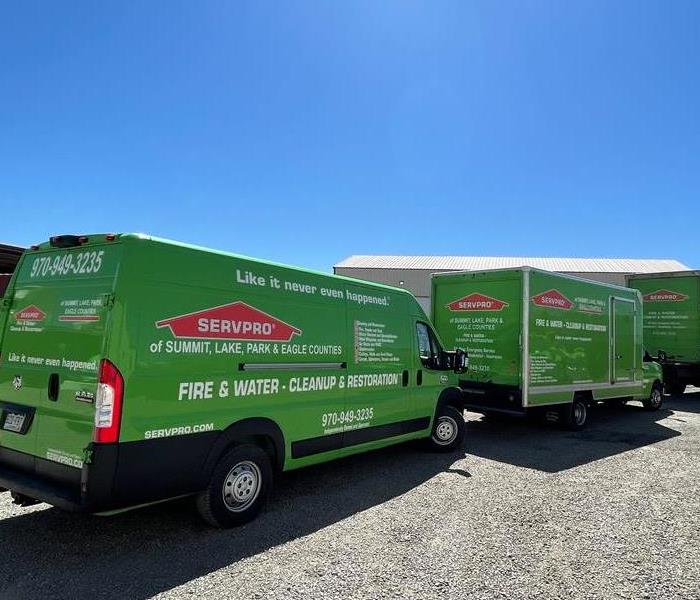
SERVPRO of NE Albuquerque strives to restore every disaster to preloss conditions. Our commitment is to suit the demands of our customers and make them feel at ease throughout the process. Our goal is to be quick and efficient so that the consumer can get back to their routine. SERVPRO of NE Albuquerque strives to achieve this goal by remaining professional throughout restoration. We can put the customer at rest during such a difficult and hectic period thanks to our experience. SERVPRO of NE Albuquerque is ready to help, no matter what the weather brings. You've put in a lot of effort to make your house a home.SERVPRO of NE Albuquerque is ready to assist you in restoring your home and personal belongings. We are working diligently to reclaim the client's residence. When you need a thorough cleaning service, you should choose a professional crew because of our precision and attention to detail. Whether it's a fire, water, sewage, mold, post-construction, or regular cleaning job, our skilled personnel brings the best tools, equipment, and chemicals to the business. We're ready for anything, and we make sure the homeowner or company owner is satisfied with the results before we leave. So give us a call today at 505-828-3567.
Storm Damage Clean Up Albuquerque Can Trust
5/18/2022 (Permalink)
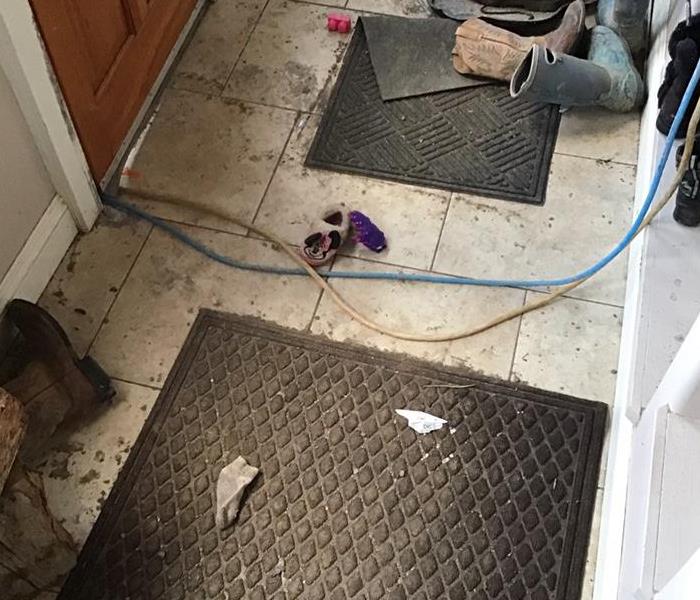 Storms can create an inside mess too
Storms can create an inside mess too
NE Albuquerque is such a beautiful area, with some of the city’s most affluent neighborhoods including High Desert and Sandia Heights. It is home to the University of New Mexico and features three shopping malls in the Uptown area.
With so much to see and do, it’s no wonder that it is such a popular area for visitors and residents alike.
Unfortunately, despite its breathtaking natural vistas, the weather here doesn’t always cooperate and storms can strike, bringing devastating damage to homes and businesses alike. Everything from rain, hail, and high winds has been known to hit this area and the aftermath can take a real toll.
For storm damage clean-up Albuquerque businesses and homeowners can trust, SERVPRO has been the company to turn to for over 50 years.
Trust The Professionals To Do The Cleaning
Storms can strike without warning, but even if you do have a head’s up, it’s not always possible to protect against damage. The aftermath of a storm can not only be costly, it can also be dangerous to try and handle on your own. That’s why you need professionals you can trust to make sure the cleanup is done right.
At SERVPRO we’ve got the training and equipment to handle any kind of storm damage and we’re prepared to respond faster to any disaster because we know how important it is to start the cleanup as quickly as possible.
That’s why we’ve got someone ready to take your call 24/7 and we’ll have someone on-site within four hours of that call to begin assessing the damage and formulating a comprehensive plan to address it.
As part of the NE Albuquerque community, we understand the damage storms can do in this area and we’re prepared to address it thoroughly. Our primary goal is to help you heal and make your property look “Like it never even happened”, so we’ll make sure to handle the job properly and treat your home as if it were our own. We’ll also be sure to stick with the job until we know you’re satisfied because helping you heal is our business.
Clean Up From Top to Bottom
SERVPRO understands the need to get your property restored quickly after a storm hits. We’d want the same for ourselves, so we want no less for our customers. We’re prepared to respond faster to any disaster and we use state-of-the-art equipment and techniques to ensure that the job is done thoroughly so that you can begin to feel whole again.
Our technicians undergo regular training in the most advanced techniques for cleanup and restoration and have received certification in everything from carpet cleaning and floor care to water damage restoration and odor control.
We’ll take you through every step of the process, from addressing any immediate threats to removing all standing water and thoroughly drying all surfaces to identifying and remediating any mold infestation.
We’re prepared to handle all sorts of damage caused by severe weather including thunderstorms, lightning strikes, hurricanes, tornadoes, hail and ice storms and freezing weather and ice dams.
No matter what Mother Nature throws at you, we’ve got the answer and we can help get you back on your feet again in no time with the professional storm damage cleanup Albuquerque can trust.
Our goal is to return your property to its previous condition and that means taking a comprehensive approach that includes:
- Damage assessment
- Water damage repair
- Wind damage repair
- Emergency board up
- Tree removal
- Structural stabilization
We’ll begin by boarding up any broken windows and using tarps to cover holes in the roof to prevent any further damage and ensure that your property is secure. Next, we’ll remove any standing water and ensure that all surfaces are thoroughly dried and sanitized.
If your property requires extensive restoration, we can also conduct an efficient move out of the affected area to protect your belongings from further damage.
Next, we’ll employ professional-grade equipment such as industrial-strength air movers and vacuums equipped with HEPA filters to remove any toxins from surfaces and from the air. This is particularly important after a storm as floodwaters can bring many hidden dangers with them such as bacteria and microbes that may be extremely hazardous to your health.
Of course, any time standing water is present that can also leave you open to the potential for a hazardous mold infestation. Mold can begin forming and spreading within 24 to 48 hours after water damage occurs, so the sooner you begin to address the damage the better off you’ll be. We have the training to perform complete mold remediation, paying particular attention to your HVAC system, where mold can easily be spread throughout the home.
Once the initial cleanup is done, we will complete the restoration by taking any necessary steps such as painting, replacing flooring, or even rebuilding entire rooms. We’ll even help you prepare to file an insurance claim by performing a complete inventory of all items in your home or business so you can get the compensation you deserve.
A Local Company With A National Reach
SERVPRO of NE Albuquerque has been proudly serving this area for many years and we pride ourselves on providing the personal touch. We also understand that some circumstances are too big for us to handle alone, and fortunately, we have the ability to reach out to a national network of 1,960 SERVPRO franchises and special Disaster Recovery Teams when major storms hit.
Living through a storm can be stressful enough without having to face a difficult and dangerous clean-up all by yourself. We get that, which is why we’re ready to stand by you every step of the way. That’s the approach to storm damage cleanup Albuquerque expects and it’s the SERVPRO difference, which you can only get from us.
When a storm leaves you reeling, trust SERVPRO to put you back on steady ground again
What to do During a Flood in Tanoan Communities
3/28/2022 (Permalink)
Flood risk isn't just based on history; it's also based on rainfall, topography, flood-control measures, river flow, tidal-surge data, and changes due to new construction and development.
- Listen to EAS, NOAA Weather Radio, or local alerting systems for current emergency information and instructions regarding flooding.
- Be aware that flash flooding can occur. If there is any possibility of a flash flood, move immediately to higher ground. Do not wait for instructions to move.
- Evacuate immediately if told to evacuate. Never drive around barricades. Local responders use them to direct traffic out of flooded areas safely.
- Do not walk, swim or drive through floodwaters; turn-Around, don't Drown!
- Stay off bridges over fast-moving water. Fast-moving water can wash bridges away without warning.
- Secure your home. If you have time, bring in outdoor furniture. Move essential items to an upper floor.
- Turn off utilities at the main switches or valves if instructed. Disconnect electrical appliances. Do not touch electrical equipment if you are wet or standing in water.
- Stay inside your car if it is trapped in rapidly moving water. Get on the roof if water is rising inside the vehicle.
If you experienced a flood or water damage in New Mexico. Call a professional flood restoration company that can help get your home back to its pre-flood condition and make it "Like it never even happened." Our highly trained technicians of SERVPRO of NE Albuquerque are available 24/7 at 505-828-3567
Authored by: Chafika and James Landers
Certifications
- AMRT -Applied Microbial Remediation Technician
- ASD -Applied Structural Drying Technician
- CCT -Carpet Cleaning Technician
- ECTP -Employee Certification Training Program
- FSRT -Fire & Smoke Damage Restoration Technician
- HST -Health and safety Technician
- OCT -Odor Control Technician
- RRRP -Lead-Based Paint Activities and Renovation
WRT-Water Damage Restoration Technician - IICRC -Certified Firm
Affiliations
- ASBO
- EPA Lead-Safe Certified Firm
- Institute of Inspection, Cleaning & Restoration Certification
Awards
- Emergency Ready Plan Preparedness
Be Prepared for Any Emergency
5/14/2021 (Permalink)
When disaster threatens a community, it is often too late to take the necessary steps to prepare homes, businesses and family members for the situation. Whether it's a blizzard, flood, hurricane or wildfire, disasters of all types often give little to no warning before they strike. The time to prepare for a storm is not as it approaches-the time to prepare is now. Inside this newsletter, you will find tips and information to help you be better prepared when severe weather strikes, including a list of items needed to create an emergency supply kit. No matter what part of the country you call home, we want to ensure you are prepared for any type of disaster. Whether you have damage caused by a hurricane, tornado, flash flood, or any other reason, your local SERVPRO of NE Albuquerque Franchise Professionals have the resources, experience and training to help get your home back in order or your doors reopened for business as soon as possible.
In 2013, there were more than 440 weather-related fatalities and nearly 2,800 injuries. Deadly weather caused more
than $8 billion in property damage. Knowing your risk of severe weather, taking action, and being an example are just a few
steps you can take to be better prepared to save your life and assist in saving the lives of others.
Know Your Risk. The first step to becoming weather-ready is to understand the type of hazardous weather that can affect where
you live and how the weather could impact you and your family. Check the weather forecast regularly, obtain a NOAA Weather Radio, and learn about Wireless Emergency Alerts. Severe weather comes in many forms and your shelter plan should include all types of local hazards.
- A weather radio is the most reliable source for weather alerts. It is designed to alert you to dangerous weather situations such as an approaching tornado, allowing you to be warned ahead of approaching storms providing time to seek shelter. In 2012, a new nationwide text emergency alert system was launched, called Wireless Emergency Alerts (WEA). The WEA system is a huge step toward keeping our nation informed in crisis situations, however it does not alleviate the need to own weather radios. The new WEA system relies on cell towers to send alerts-if cell towers are knocked out during bad weather or are no longer sending a signal, you will not receive alerts. Television and radio broadcasts can also go down during a destructive event. Having a back-up such as a weather radio is critical to ensure you still receive information in the event media outlets can no longer broadcast or you are unable to receive the broadcast.
- When selecting a weather radio, ensure it includes SAME alert programming-sounds an alert only when specific counties are threatened (allowing you to only receive alerts for your county) and review-able alerts (allowing you to turn off alerts you do not want to hear).
Take Action. Take the next step in severe weather preparedness by creating a communications plan for your home or business. Put together or purchase an emergency kit. Keep important papers and valuables in a safe place.
Be an Example. Once you have taken action to prepare for severe weather, share your story with co-workers and family and friends on Facebook or Twitter. Your preparedness story will inspire others to do the same.
Preparation is the key to making it through any size disaster and having a plan in place may help minimize the amount of time your home or business is inactive and get you back in the structure faster following a disaster. Don't wait until disaster strikes. Call your local SERVPRO of NE Albuquerque Franchise Professional to establish an Emergency READY Profile® for your home or business and be "Ready for whatever happens."
Wildfire Safety Tips
- Clear leaves and other debris from gutters, eaves, porches and decks. Remove dead vegetation from under your deck and within 10 feet of the house. This prevents embers from igniting your home.
- Remove anything stored underneath decks or porches. Screen or box-in areas below patios and decks with wire mesh to prevent debris from accumulating.
- Ensure flammable materials (firewood stacks, propane tanks, dry vegetation) are more than 30 feet from your home or business's foundation and outbuildings.
- Wildfire can spread to treetops. If you have trees on your property, prune so the lowest branches are 6 to 10 feet from the ground.
- Keep your lawn hydrated and maintained. If it is brown, cut it down to reduce fire intensity. Dry grass and shrubs are fuel for wildfire.
Tips and information provided by the National Fire Protection Association's Firewise® program.
Power Outage Preparedness
5/14/2021 (Permalink)
Before the Outage
- Create an emergency preparedness kit. This should include a flashlight, batteries, and first aid supplies.
- Keep a spare power source available to charge cell phones and any other important devices that require power.
- If you have an electric garage door opener, make sure you know where the manual release lever is located and how to operate it.
- Use ice and frozen water bottles to help keep perishable food cold.
- Keep your vehicle's gas tank full to make sure it’s available for immediate use. Additionally, if you use your vehicle to charge your phone or other devices, don’t keep your car running in a closed space (such as a garage) as this can cause carbon monoxide poisoning.
- Learn and keep copies of your communities pre-established emergency preparedness plans. These can help you locate available shelters to help keep you warm/cool and provide assistance as needed.
- Create a backup plan for any essential, power-dependent medical devices that you rely on.
During the Outage
- Prioritize the use of flashlights for emergency lighting over candles. If not careful candles can cause fires.
- Don’t open refrigerator and freezer doors closed unless absolutely necessary. An unopened freezer can keep cold for approximately 48 hours; while an unopened refrigerator can keep items cool for approximately 4 hours.
- If it’s cold outside, layer up with warm clothing. Never attempt to burn charcoal indoors to keep warm or cook food with. Never use an oven as a source of heat. If the power outage is for an extended period of time, make arrangements to go to another house or public facility that has a reliable form of heat to keep warm.
- If it’s hot outside, drink plenty of water to help you stay cool, even if you don’t feel thirsty. Consider going to a cooling shelter, movie theater, or shopping mall that might be open around you. If you decide to stay at your own home, move to the lowest level of your home since cool air falls. Additionally, wear lightweight light-colored clothing.
- Consider using surge protectors in the event of a power surge; otherwise, unplug your electronics as a sudden power surge can cause permanent damage to your electronic devices.
- Talk to an electrician or engineer before purchasing and installing a generator for your home
- Make sure any generator you use is away from your house and don’t connect it to your home's electrical system for use inside your home.
After the Outage
- If you have any perishable food that was at 40°F for more than at least 2 hours, has a non-normal odor, color, or texture, dispose of it immediately. Better to be safe than sorry!
- If food in your freezer is colder than 40°F but still has ice crystals on it, it can still be frozen again and recovered.
- Fully restock your emergency kit with all new supplies.
Understanding weather advisories
5/7/2021 (Permalink)
New Mexico and other areas across the Southwest U.S. are affected by the North American Monsoon System (NAMS) every summer, and the “Monsoon Season” is designated as the period lasting from June 15th through September 30th. With the onset of the Monsoon, New Mexico is typically impacted by a variety of weather hazards that can often put the population at risk for serious injury or death. Thunderstorm frequency increases during this period, while exceptionally hot days are common as well. These pages were prepared to help promote awareness of the life-threatening weather hazards that affect New Mexico during the Summer Monsoon.
Despite the desert environment of the Land of Enchantment, statistics indicate that significant weather events associated with the Monsoon are responsible for property damage, injuries and fatalities across the state every single year. In 2010, monsoon related events were responsible for two fatalities in New Mexico.
As a result, we urge all residents and visitors to become familiar with the hazards associated with the Summer Monsoon. Please take the time to review safety rules that could save your life or help prevent serious injury. Community governments and businesses should review their emergency action preparedness plans and are urged to conduct drills to train staff and employees in flash flood procedures.
The best way to avoid lightning, flash floods, and other dangerous weather events during the monsoon season is by staying alert of the weather conditions and avoiding the threat before it occurs. Many opportunities are available to gain weather information including:
- Monitoring current weather forecasts on TV or the internet.
- Listening to weather reports on the radio or a NOAA weather radio.
- Subscribing to lightning and severe weather notification services.
- Scanning the skies 360 degrees around and overhead before leaving a safe location.
Understanding Watches, Warnings, and Advisories:
Watches (Severe Thunderstorm, Flash Flood, and Tornado, for example) mean that widespread severe weather or flash flooding is possible. A watch means that severe weather or flash flooding has not yet occurred, but weather conditions are becoming highly volatile. Pay close attention to the weather, and tune into TV, radio, or NOAA Weather Radio broadcasts regularly.
Warnings (Severe Thunderstorm, Flash Flood, Tornado, Dust Storm, Excessive Heat) mean that life-threatening weather is about to occur, or has been reported. Take action immediately.
Areal Flood Advisories mean heavy rains will cause minor flooding of washes, streams, and typical flood-prone areas. Flooding in this situation is usually not serious. If the flooding does become life threatening, then the flood advisory is upgraded to a Flood Warning.
Warnings are not issued for lightning, mainly because thunderstorms, no matter how weak, can produce deadly cloud-to-ground lightning. Any time thunderstorms are in the area, lightning is a serious threat. This is supported by the fact lightning is the number one killer in New Mexico, with 84 deaths since 1959.
Protecting your home from storm damage
5/7/2021 (Permalink)
Rain isn’t the only thing leaving its mark on our homes. Springtime may have just passed, but storms are still whipping through cities causing power outages and home damage. According to the National Storm Damage Center (NSDC), damage caused by trees during severe weather account for over $1 billion in property damage. Broken limbs or trees can cause mass amounts of damage to your property if they make contact. Such damage can be done to roofing, siding, windows and even structure to the home, causing lots of expensive repairs. Unfortunately there is no way to stop the unpredictable weather, but there are ways to prevent damage from happening to your home.
Assessing your tree
The National Storm Damage Center insists on trying to keep trees healthy and surviving as long as they’re not posing an immediate threat, but how do we know if the tree is ready to be taken down or not? There are different ways that a tree can be assessed to give you a better answer to that question.
Broken limbs – the larger amount of large limbs that are broken on a tree, the less likely it is to survive or recover from storm damage. This tree is unfortunately probably ready to be taken down.
Amount of limbs broken – A tree showing more than 50% of its limbs broken or damaged means that it will most likely have a difficult time producing leaves in the upcoming season, therefor making it harder for it to survive.
Leader branch – Is the upward-trending branch at the top of the tree broken? Without this branch being intact, it is likely that the tree’s growth will be stunted, making it less likely to survive.
Location – Last, but not least is location. Saving trees is important for our environment, but keeping lives safe is obviously more important to us. The biggest decision on whether to keep a tree in your yard or not is purely the location of the tree. Is it in a location that could cause damage or injury to your home, car or family if it were to break? If so, it is better to be safe than sorry and get it removed before a storm comes through.
If the unthinkable happens and you have a tree or storm damage, call SERVPRO of NE Albuquerque today!
Summer Storms Wreak Havok All Over the World and Albuquerque is no Different
12/27/2019 (Permalink)
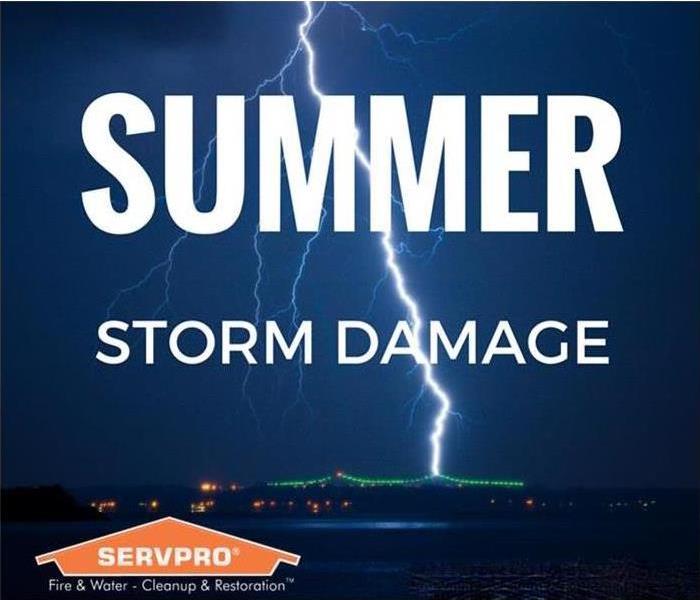 If your house has sustained significant water or fire damage call SERVPRO of NE Albuquerque. (505)-828-3567
If your house has sustained significant water or fire damage call SERVPRO of NE Albuquerque. (505)-828-3567
Summer storms can lead to fires, floods, power outages, lightning strikes, wind damage and more. To make sure you and your family stay safe during the summer storms in Albuquerque follow these 5 important tips and procedures!
- Have a Summer Storm Damage Survival Kit.
- Stay inside and away from windows if possible.
- Use flashlights and headlamps instead of candles.
- Unplug as many appliances as possible.
- Try not to open refrigerators or freezers while the power is out.
When the summer storm settles and power is restored do a survey of everything that might be broken or missing. Also, make sure all family members and pets are accounted for.
If your house has sustained significant water or fire damage call the local authorities first, then call SERVPRO of NE Albuquerque. (505)-828-3567. We will help any way we can.
Flood Damage Clean Up
12/27/2019 (Permalink)
Restoring your home or business after a flood is a difficult job. Depending on the severity of the flood, you may have to deal with structural damage, electrical damage, and potential health hazards. Before you begin dealing with the flood cleanup, ask yourself these questions:
Time is a crucial factor in a flood damage restoration project. The longer your belongings stay in the water, the worse the damage will be. Any area that is not dried thoroughly within 24 hours may have long-term mold problems. Can you afford to take several days or weeks off work to clean contaminated water and mud out your home? Once the water is removed, your belongings must be dried and restored. If you hire a professional flood restoration company, you can focus on getting your personal life back to normal faster as the flood damage in your home will be taken care of.
- Do you have the expertise?
Flood damage cleanup is a multi-stage process. First, the floodwater must be pumped out and the area thoroughly dried. During this process, you will need to mitigate safety concerns due to the weakened structure of your home. There will also be health hazards as you will have to deal with bacteria and mold. You will have to decide which of your possessions can be saved and what must be thrown away. Only then can you begin the actual flood repair work to make your home livable again.
- Do you want to do the work?
Flood damage cleanup is dirty, often hazardous work. After the flood incident is over, do you want to face the job of cleaning contaminated water and mud out of your home, then sort through your possessions to see what can be saved? The emotional impact of flood cleanup can be significant and can interfere with other aspects of your life. Hiring a professional to do flood damage restoration is an investment in your mental and emotional health.
Make Sure to Prepare
12/24/2019 (Permalink)
In recent years, many different types of disasters have affected the United States. Flooding, tornadoes, hurricanes, wildfires and blizzards are natural disasters that can threaten your home, business and community. Your local SERVPRO of NE Albuquerque Franchise Professionals want you and your customers to be aware of the steps to take to help prepare for Mother Nature's worst.
Right now is the perfect opportunity to review your emergency plan. Emergencies can happen unexpectedly in communities just like yours, to people just like you. Tornado outbreaks, river floods, flash floods, historic earthquakes, and even water main breaks and power outages in U.S. cities affecting millions of people for days at a time.
The more you know about what to do in an emergency, the more confident and secure you will feel in your abilities to manage through a disaster. Preparation is the key to making it through any size disaster, whether it is a small water leak, a large fire, or an area flood. The best time to plan for such events is not when the event happens, but well before it happens. No one ever plans on a disaster, but now, you can plan for it. Contact your local SERVPRO of NE Albuquerque (505)-828-3567 for more information and tools to help you be "Ready for whatever happens."
Step by Step Lightning Preparedness
12/24/2019 (Permalink)
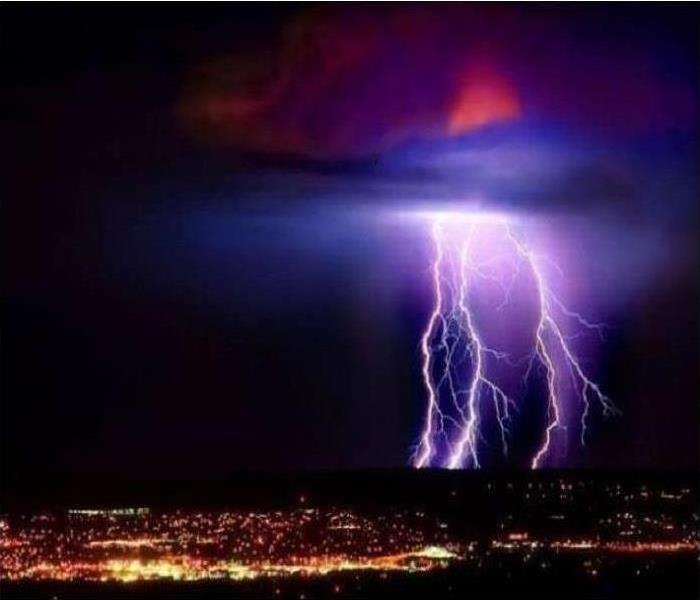
Lightning causes around 31 deaths in the U.S. annually (based on statistics from 2006-2016). Nationally, lightning ranks second only to flash floods in weather-related deaths. Lightning is the most frequent important weather threat to personal safety during the thunderstorm season, and it is also the MOST UNDERRATED weather hazard. Unfortunately, New Mexico has observed several lightning fatalities and injuries. Why? The main reason is that people stay outside too long as thunderstorms approach or form nearby. During the early part of the thunderstorm season, for example May and June, "dry" thunderstorms are quite common. With these types of thunderstorms, little or no precipitation reaches the ground and, as a result, people are less likely to seek shelter. Click below for statistics on lightning events (resulting in property or crop damage, injuries or fatalities) by month and by hour. While most lightning casualties occur at the beginning of an approaching storm, a significant number of lightning deaths occur after the thunderstorm has passed. If thunder is heard, then the storm is close enough for a lightning strike. DO NOT wait for the rain to start before seeking shelter, and do not leave shelter just because the rain has ended. Did you know?
- The air near a lightning strike is heated to 50,000 ° F, which is hotter than the surface of the sun!
- The average flash could light a 100-watt light bulb for more than 3 months.
- Lightning occurs with all thunderstorms.
It's not raining, is there still danger from being struck by lightning? YES! Lightning often strikes outside of the heavy rain area and may occur as far as 10 miles away from any rainfall. Will the rubber soles of my shoes or tires on my car protect me from being struck? NO! However, the steel frame of a hard-topped car provides increased protection if you are not touching metal. Although you may be injured if lightning strikes your car, you are much safer inside the car than outside. To roughly estimate the distance in miles between you and the lightning flash, count the seconds between the lightning and the thunder and divide by 5. When skies darken or thunderstorms are forecast, look and listen for increasing wind, flashes of lightning, sounds of thunder, and static on your am radio. While no place is safe from lightning, some places are much safer than others.
When Thunder Roars, Go Indoors!
- Get inside a house, large shelter or an all-metal vehicle (not a convertible).
- Do not use a corded telephone during a thunderstorm. Only use cordless or wireless phones instead.
- Remain clear of tall, isolated trees and telephone poles.
- Stay away from wire fences, clotheslines or metal pipes and rails.
- If you are caught outside, away from shelter, you need to get to a place of safety as quickly as possible.
- Wait 30 minutes after you hear the last rumble of thunder before going outside.
What you can do...
- Watch for signs of an approaching thunderstorm
- Postpone outdoor activities if thunderstorms are imminent. This is your best way to avoid being caught in a dangerous situation
- REMEMBER if you can hear thunder, you are close enough to a storm to be struck by lightning
- If possible, move to a sturdy building or hard top automobile
- If safe shelter is not available, find a low spot away from trees, fences, and poles
- If boating or swimming, get out of boats and away from the water, get to land and find shelter immediately
Sourced: https://www.weather.gov/abq/preplightning
When it Rains it Pours.....in Albuquerque
8/7/2017 (Permalink)
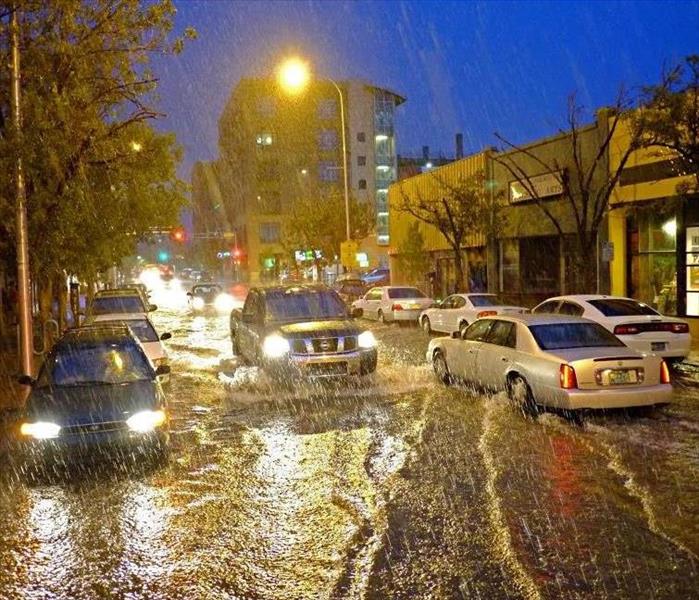 Traffic streaming through the flooded streets on Gold Street between 2nd and 3rd.
Traffic streaming through the flooded streets on Gold Street between 2nd and 3rd.
4:20 p.m. — Albuquerque mayor Richard Berry called the storm that pummeled Albuquerque and other parts of the state Friday night a “Category 1 hurricane”, and he asked residents to check on their neighbors as he outlined resources for folks preparing for another storm.
Sand bags are available at all Albuquerque fire stations, and piles of sand can be found at stations 1, 6, 7, 18 and 19, Berry said. Police and firefighters have been out all day doing damage assessments and responding to calls for service.
Some 5,950 households were still without power Saturday afternoon, down from more than 30,000. PNM officials said that it’s not possible to predict when those customers will again have power.
“Some customers may be out for quite some time due to the severity of the damage caused by the microburst, unfortunately. We know it is frustrating. We will try to keep you posted,” PNM posted on its Facebook page.
Berry and police chief Ray Schultz patrolled the city until 1:30 a.m. last night, the mayor said, surveying damage and assessing what the costs could be. Berry said that the early Friday morning storm, which hurled huge thunder claps and brilliant flashes of lightning all over the city, cost $500,000. That doesn’t even include the Friday night storm, which appears to have been more damaging.
The city’s Senior Affairs division is doing welfare checks around the city, Berry said, but he asked residents to look out for each other, knock on doors and make sure neighbors are fine.
“Check on them,” Berry said. “Make sure they’re doing OK.”
As of 12 p.m., 25 traffic signals were out of power. That means drivers should treat those intersections as a four-way stop.
Elsewhere, Bridge between Fourth and Eighth Street was closed as crews repaired damages, and four city pools — Valley, Rio Grande, Highland and Sunport — were closed.
The Rio Grande Zoo saw no injuries to animals or humans during the storm, which caused the abrupt cancellation of a Friday night concert. Watching this video of the storm at the zoo, it’s surprising no one was hurt.
The zoo will reopen tomorrow, but was closed today. Concertgoers who abandoned personal property can describe their lost items to zoo staff in order to retrieve them, Berry said.
An emergency radio communications tower struck by lightning early Friday morning was not at “100 percent”, the police chief said, but officers have been doubling up, using cell phones and using other backup methods to prevent any impact in emergency response. The tower is expected to be fixed in the next 24 hours.
2 p.m. A flash flood watch for part of northern and central New Mexico, including for the Albuquerque metro area, is in effect through late tonight, according to the National Weather Service.
“Abundant moisture already in place will increase further this afternoon and evening as a weak disturbance draws even deeper moisture from Arizona into New Mexico,” the Weather Service says. “Slow moving thunderstorms with rainfall rates near 2 inches per hour are possible with the stronger thunderstorms.”
The Friday night thunderstorm that hit the Duke City turned out to be a record breaker.
The Weather Service reports that a record rainfall of 1.36 inches was set in the city on Friday. “It breaks the old record of 0.85 inches set in 1939,” according to the agency.
Some parts of the Valley received nearly 2.5 inches of rain since Friday afternoon.
Also, the 89 mph gust measured at the Albuquerque International Sunport on Friday at 7:36 p.m. “is the strongest gust recorded at Albuquerque Sunport since 1939.”
The two days of rain have turned the Rio Grande into a river again, if only temporarily. Flows on the Rio Grande peaked at 3,070 cubic feet per second at the Central Avenue bridge in Albuquerque at around 10 a.m. this morning, the highest flow since the spring runoff in 2010.
Today, residents cleaned up and authorities worked to fix traffic lights and restore power to thousands affected by the Friday night storm.
Emergency management officials urged residents to avoid major roadways as workers battle the aftermath of floods and downed trees and utility lines, The Associated Press reported.
Authorities said most of the water that created havoc on streets had receded today and street signs or police officers had been placed at more than two dozen intersections to handle malfunctioning traffic signals, the AP said. Officials said the storm also caused minor damage to a levy.
“Right now we need time to restore basic services,” Director of Emergency Management Roger Ebner said in a statement. “The best thing the public can do is to stay home, relax and enjoy their weekend while crews work to restore power, clean the roadways and assist motorists.”
Police said that traffic control officers or street signs were at more than two dozen intersections to handle malfunctioning traffic signals, according to the AP report.
1:45 p.m. Albuquerque Public Schools was reeling from Friday night’s storm on Saturday, with maintenance crews called in for clean-up and principals called in to inspect their school buildings.
“We got hammered,” said APS Superintendent Winston Brooks. He said crews began working at 3 a.m., and he directed every principal to go to their school and walk through each classroom checking for damages.
One of the most intense thunderstorms in recent memory slammed into the Albuquerque metropolitan area Friday night, flooding streets, toppling power lines and leaving more than 27,000 people without electricity.
Gusts of nearly 90 mph blew past the Albuquerque International Sunport, and police had to shut down a section of Interstate 25 from the Big I to Rio Bravo to clean up power lines that fell near Gibson Boulevard. Flooding and stalled vehicles were also reported near Alameda and Rio Grande and along Coors between Eagle Ranch and Irving. Trees were uprooted and debris was strewn about.
“Metro experienced one of the most intense rain, severe wind-producing storms in recent memory, if not on record,” the National Weather Service in Albuquerque posted on Twitter on Friday evening.
An inch of rain fell Friday evening at the Sunport, and northeastern parts of the city also saw between 1.6 and 1.8 inches of rain, according to preliminary reports.
And it fell quickly.
Mark Summerlin, 24, was driving his parents’ Buick sedan west on Central Avenue under the Downtown bridge, which had flooded, when his car stalled. He sat in his vehicle as water levels rose, and continued rising, to above the center console.
“It started getting higher, so then I called 911,” Summerlin told the Journal on Friday. “… Once they got there they just pulled me out of the car and walked me out.”
An Albuquerque firefighter hoisted Summerlin onto his shoulders and walked out from under the bridge as waters reached to above chest.
“I was very anxious to get out of the car,” Summerlin said.
The Buick, which sat empty under the bridge until around 11 p.m., entered the underpass behind several other vehicles, Summerlin said, and still others passed him when he stalled.
“It seemed like it was about to get through, but then it just died out,” he said. “I should have got a Jeep or something like that.”
Apart from the flooding, the storm knocked out power in areas all over the city. PNM crews had to wait for a couple of hours before they deemed it safe enough to begin restoring power to the 27,581 homes without power.
More than 2.7 inches of rain have fallen at the Sunport this month, making it the 10th wettest July on record, the National Weather Service reported Friday night.
When the storm left the city, it continued south. A National Weather Service meteorologist said the storm didn’t appear to lose intensity as it moved south, though the service received only one report of a flooded road in Belen. More damage will likely be assessed today, she said.
Flooding damage was also reported at the ABQ BioPark zoo and other parts of the BioPark, prompting officials there to close the zoo today, and possibly even close the botanic garden and aquarium, which were left without power. Today, staff was going to be cleaning up tree limbs and other storm debris.
Also, attendees of the Luke Bryan concert at the Isleta Amphitheater had to flee to their vehicles when the storm hit. The show was quickly cancelled, leaving the musician “bummed,” according to his Twitter page.
The National Weather Service reported gusts of up to 89 mph at the Sunport.
A flash flood warning was extended twice Friday night, from 9:30 p.m. to 11:30 p.m. That warning included all of Bernalillo, Sandoval and Santa Fe counties, and officials warned that, even though the heaviest rains didn’t fall for more than a few hours, the flash flood danger persisted in area ditches and arroyos.
Albuquerque police even had to call in additional officers to help deal with damage large and small all over the city, and officers were still directing traffic off the Interstate as of 10 p.m. They warned drivers to stay out of underpasses underneath Interstate 40 and Third through Sixth streets.
The levee at Bridge and Central was also damaged and potentially dangerous to the public, police said.
A weaker storm system was expected for today but the potential for flash flooding is forecast to persist until things start to dry out on Sunday.
Sourced from: https://www.abqjournal.com/226329/rainstorm-pounds-duke-city.html
Winter storm drops April snow across northeast New Mexico
5/9/2017 (Permalink)
ALBUQUERQUE, NM -- Much of the state braced for the winter storm that hit over the weekend.
Temperatures dropped sharply as the storm started to move into the state Friday night.
Snow fell across most of the storm’s path and dropped 10 inches of snow in Tijeras, 15 inches in Tererro, and just over 8 inches in portions of Santa Fe.
The snow came as a surprise for travelers to the area, and some took the weather as a second Christmas.
“I was greeting tourists all over saying Merry Christmas to then in the spring,” said Myles Calladitto.
“I love it. I’m all for it. I feel like time traveled back to Christmas time and it’s amazing. Yes, I have Christmas music on,” said Lucero Maldonado.
Several roads had to be closed due to the snow. HW 64 is still closed between Clayton and Raton due to the snow and ice. I-25 is covered and in ice and snow and caution should be used in the Watrous area near mile markers 364 to 402.
Eastbound I-40 was closed starting near Zuzax. Crews spent the day clearing the roads and most roads are open.
Road conditions can be found on NMroads.com.
The KOB weather team will be watching the storm as it develops with active radar and updated forecasts can be found in the weather section.
Source: KOB News





 24/7 Emergency Service
24/7 Emergency Service
